A perspective of the engineering applications of carbon-based selenium-containing materials
2021-12-29XinruiXioZhifngShoLeiYu
Xinrui Xio,Zhifng Sho,*,Lei Yu
a Guangling College,Yangzhou University,Yangzhou 225000,China
b School of Chemistry and Chemical Engineering,Yangzhou University,Yangzhou 225002,China
Keywords:Selenium Carbon Reaction engineering Bio-activity Agricultural and food chemistry Catalysis
ABSTRACT Carbon-based selenium-containing materials are novel materials just being invented recently.Owing to the low cost and bio-compatible features of carbon and selenium,these materials are practical.The unique chemical-and bio-activities of selenium endow them wide range of applications in catalysis,environment-protection,fertilizer and biocide development etc.Recent progresses in this field are summarized and prospected from the engineering application viewpoint in this mini-review.
1.Introduction
Selenium science is booming in recent years [1-8].As a chalcogen element,selenium possesses unique chemical-and bioactivities endowing the related compounds and materials broad application scopes [9-17].Selenium is a metalloid with dual properties of both metal and nonmetal elements.Formation of the selenium-containing covalent bond allows the element being firmly anchored on support to fabricate the stable materials.However,the Se--O bond is not very strong and this feature makes the element an oxygen carrier in catalytic reactions[18]as well as the antibacterial agent for increasing the bacterial intracellular reactive oxygen species [19].In comparison with other metal or nonmetal elements,selenium has many advantages.First,its cost is relatively cheap,and since China possesses abundant selenium resources,developing the related industries is hardly restricted by the starting materials.Secondly,as selenium can be metabolized in the body [20],it is relatively safe for the environments and the residue tolerance of selenium is obviously higher than that of the other metal elements according to the latest revision of the U.S.pharmacopeia’s new standard and method for elemental impurities control published in 2017 [21].
With the deepening of the research on selenium catalysis,we began to pay attention to selenium-containing materials because they might serve as recyclable heterogeneous catalysts with profound industrial application prospects.Polystyrene-supported selenic acid,a waste in the selenium-based solid synthesis [22],was initially designed and prepared as the first heterogeneous selenium catalyst in our group.Although the material could catalyze the dihydroxylation reaction of cyclohexene to prepare trans-1,2-cyclohexanediol under mild and green conditions,its tedious fabrication processes might caused heavy pollution in large-scale production and prohibited the further applications in industry [23].Polyselenides were then developed and the materials could be fabricated in more concise way,but the use of halogen-containing chemicals to prepare the materials was still environment unfriendly [24,25].Carbon is an abundant and biocompatible element and the carbon-based materials have many advantages,such as low cost,easy to manufacture and environment-friendly [26-28].Therefore,we have paid attention to the field and invented a series of carbon-based selenium-containing materials,such as the carbohydrate-supported selenium,selenium-doped carbon (Se/C) and selenium-doped polymeric carbon nitride (PCN-Se).The materials were then found to possess broad application potentials not only in catalysis,but also in environment-protection,agriculture and food chemistry,etc.,and some of the related techniques have already been industrialized andcommercialized.Herein,we wish to summarize the recent progresses and give a prospect from the engineering viewpoint.
2.Carbohydrate-supported selenium
Selenium is a necessary trace element for human beings.The world health organization (WHO) suggested that the everyday intake of selenium for adult should be 50-400 μg.Unfortunately,although China possesses abundant selenium mineral resources,most of its areas (ca.70%) are deficient in selenium,especially for the East China where the population density is very high[29].Selenium deficiency can cause a series of health problems,such as cardiovascular disease,low immunity,heavy metal poisoning,cancer,etc.Nowadays,taking selenium supplement,as a health care method,is being gradually accepted by the public in China.
However,excessive intake of selenium may also cause health problems.For example,continuously taking over 2400 μg of Se everyday for several months may cause the chronic selenium poisoning.Therefore,in our cases,we paid attention to planting selenium-enriched agricultural products because in comparison to the selenium supplements on the market,they are even safer and more acceptable to the public.Selenium fertilizer is the key for planting selenium-enriched agricultural products.However,although a series of selenium fertilizers have already been commercialized,their shortcomings are also obvious.The composting of selenium ore is cheap,but may bring heavy metal pollutants into the field and does not agree with the principle of“precise fertilization”[30].Sodium selenite is cheap and can introduce selenium into the plants precisely,but the high toxicity of the chemical makes it unsafe for environments [31].Seleno amino acids,such as selenocysteine,selenomethionine and the derived selenium yeast,are safe,but the too expensive prices prohibit them being used as selenium fertilizer in large-scale applications.
Indeed,from the element transfer viewpoint,planting selenium-enriched agricultural products is a process of selenium element transfer process.Selection of a cheap,bio-compatible and water soluble selenium carrier is the key to design selenium fertilizer.Carbohydrates are ideal selenium carriers because they are abundant,cheap,bio-compatible and water soluble.There are a lot of oxygen-containing groups such hydroxyl and carbonyl in the molecules of carbohydrates and they are easily selenized.Low valent selenium species,such as HSe-,is a very strong selenization reagent [32]and can replace the oxygen in carbohydrates to prepare the partial selenized materials.Glucose was finally chosen as the carrier because it was a stable powder with low hygroscopicity.The partial selenized glucose (i.e.,glucose-supported selenium) was prepared via the reaction of glucose with NaHSe,which was initially generated in situ via the reduction of selenium powder with NaBH4in ethanol.Kilogram production of the material has already been achieved[33].The process involves two steps:1)the selenization reagent generation(Fig.1,first line);2)the glucose selenization(Fig.1,second line).The operations are generally simple and no special equipment is required,making this technique easy to implement in engineering.The material is now commercially available and can be purchased at an acceptable price.
Field experiments attested that glucose-supported selenium was an efficient fertilizer.It was used by foliar spraying and could obviously enhance the selenium content in agricultural products.For example,using glucose-supported selenium containing 33 mg of Se for each 100 m2area could enhance the selenium content in rice to over the requirement of GB/T 22499-2008 (i.e.,40 μg/kg).Notably,unlike other foliar fertilizers,the use of carbohydratesupported selenium does not require any surfactant because the hydroxyl groups in the material can well combine with the surfaces of the plant that are majorly composed of cellulose with a lot of hydroxyls.This feature reduces the cost and makes it an even more environment-friendly and precise fertilizer.The simple composition and good stability of this selenium fertilizer also makes it easy to realize in agricultural engineering,e.g.,the fertilization process can be carried out via unmanned aerial vehicle spraying together with some pesticides without decomposition.Applications of carbohydrate-supported selenium as fertilizer in the production of other selenium-enriched agricultural products such as cowpea,Tarocco blood orange,kiwifruit,hickory chick,strawberry,rapeseeds etc.,have also been successfully achieved in Sichuan,Jiangsu and Qinghai provinces (Fig.2).The fertilizer has been applied in more than 1000 mu of land in 2020 and the application area will double in 2021.
Glucose-supported selenium is not only used to improve the selenium content of agricultural products,but also to control some agricultural diseases.For example,wheat scab disease,one of the major wheat diseases (Fig.3a) caused by Fusarium graminearum (F.g.) species complex,can lead to the mycotoxin deoxynivalenol(DON,Fig.3b)generation in product[34].Intake of DON may cause acute poisoning symptoms such as vertigo,fever,nausea,diarrhea.In severe cases,it may cause bleeding,affect immunity and fertility,and pose a direct threat to human and animal health and life safety.Therefore,crops infected with wheat scab must be destroyed,resulting in great economic losses.At present,more than 300 kinds of fungicides have been registered in the ministry of agriculture of China to control wheat scab diseases.Carbendazim,thiophanate methyl,thiram and related compound preparations accounted for more than 90% of the total number of registrations.However,F.g.is easy to produce a high level of resistance to carbendazim.Meanwhile,the use of fungicides may pollute the environment,while the residues of fungicides may cause secondary damage to human and animals.In addition,although some fungicides can inhibit bacteria,they may stimulate the production of toxins on the contrary.Inhibition of the DON toxin accumulation is actually the key from the perspective of food safety.
Recently,Li group at College of Agriculture of Yangzhou University investigated the application of selenium on wheat scab disease control [35,36].It was found that,although glucosesupported selenium could not restrain the F.g.growth as good as inorganic selenium such as Na2SeO4,it could completely restrain the accumulation of DON.Animal experiments showed that the toxicity of glucose-supported selenium was obviously lower than inorganic selenium.For example,LD50on mice of the glucosesupported selenium with 0.59% weight content of Se (Sichuan Selewood Technology Co.,Ltd.) was 246 mg/kg,and this is much lower than that of Na2SeO4(LD50=1.6 mg/kg)[35].Thus,this biocompatible selenium-containing material may lead to a safe and environment-friendly protocol for wheat scab disease control.The related experiments on wheat in vivo and in field environments are in progress to attest its reliability in large scale applications.
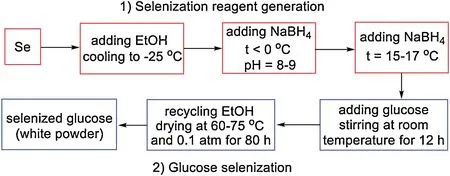
Fig.1.Process route diagram of the kilogram-scale production of selenized glucose(first line:selenization reagent generation;second line:selenization process).
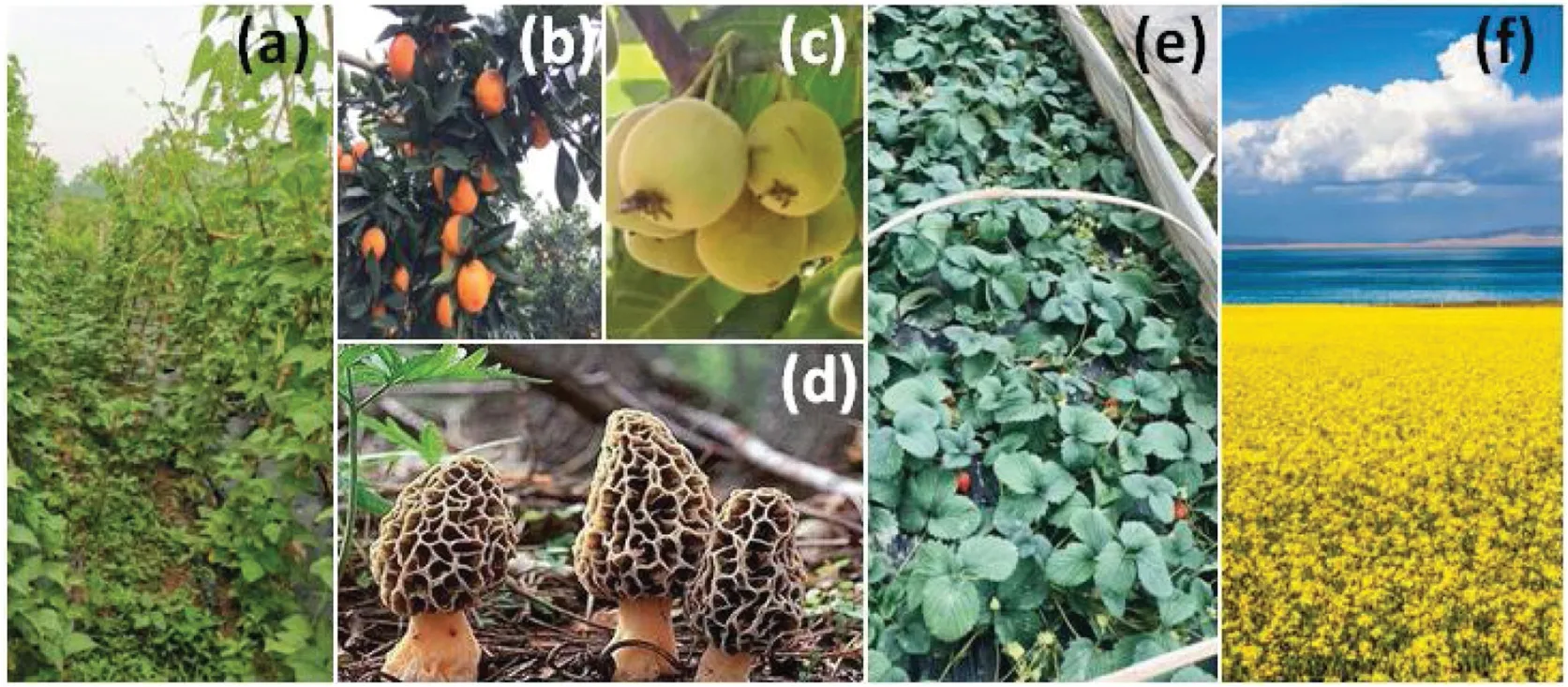
Fig.2.Production of the selenium-enriched agricultural products in Selewood planting bases:(a) Cowpea;(b) Tarocco blood orange;(c) Kiwifruit;(d) Hickory chick;(e) Strawberry;(f) Rapeseeds.
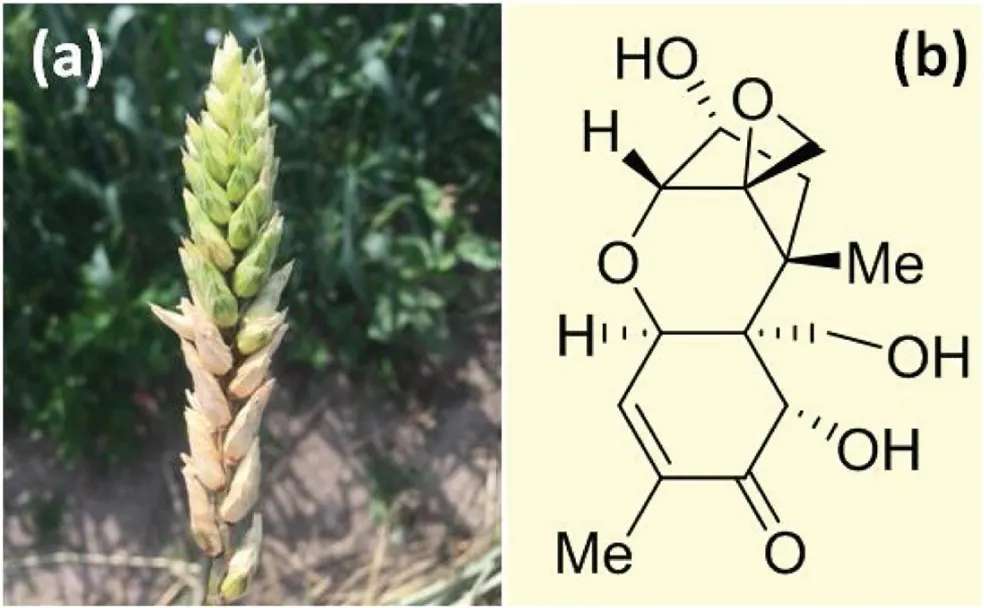
Fig.3.Disease symptoms of wheat scab disease(a),and the chemical structure of mycotoxin DON (b).
The relatively low toxicity of glucose-supported selenium makes it possible for its application as feed additive.Very recently,Gong et al.reported that the diet supplemented with glucosesupported selenium was beneficial for the health of laying hens[37].It could enhance glutathione peroxidase (GSH-Px) activity and total antioxidant capacity(T-AOC)in the spleen and oviduct as well as the scavenging ability of 2,2-diphenyl-1-picrylhydrazyl free radical (DPPH•) in the oviduct,resulting in the enhanced antioxidant capacity to reduce the damage to animal caused by oxidative stress.
3.Selenium-doped carbon
As a carbohydrate,the dehydration and carbonization of glucose-supported selenium could occur at high temperature.Calcining the material at over 500°C produced Se/C,which was majorly composed by carbon with few doping selenium less than 0.1% (Eq.1),which,as selenium-containing material,might serve as the recyclable heterogeneous selenium catalyst with industrial application potential.

The material was initially applied in the catalytic oxidation of βionone,which might produce a series of products useful for pharmaceutical and perfume industry [38].It was found that the Se/C-catalyzed oxidation of β-ionone(1)with H2O2occurred at its endocyclic C=C selectively to produce the epoxide 3 product in 62%yield (Eq.2) [39].The catalyst was recyclable,but the catalytic activity of the used Se/C reduced due to the damage of the surface structures of the material leading to the loss of partial selenium,as shown in the scanning electron microscopy images of the used catalyst[39].Fortunately,this issue does not affect the application of this material in industry from engineering viewpoint because:first,the cost of the material is cheap and just one-time use of the catalyst is acceptable for fine chemical production;second,the used material,with carbon as its major component,can be eliminated by incineration with little solid waste generation.

The mechanisms of the reaction are illustrated in Scheme 1.Selenium in the material existed in its selenic acid form(1),which could be oxidized by H2O2to generate carbon-supported peroxyselenite as the oxidative species (4)[40].As being attested by UV-vis spectrophotometry analysis,β-ionone(2)could be well absorbed on the carbon support of the catalyst,drawing close the reactive selenium sites with the substrate.Electrophilic addition of the positive Se with endocyclic C=C led to the intermediate 5,which soon rearranged into the cyclic intermediate 6 [41].Decomposition of 6 led to the epoxide 3 and regenerated the catalyst 1 to restart the catalysis circle.Quantitative calculations demonstrated that the reaction was a exothermic process,and the absorption of the substrate on carbon support as well as the electropositivity of the Se sites ensured the reaction occurring via the epoxidation route,other than the Baeyer-Villiger oxidation[42].
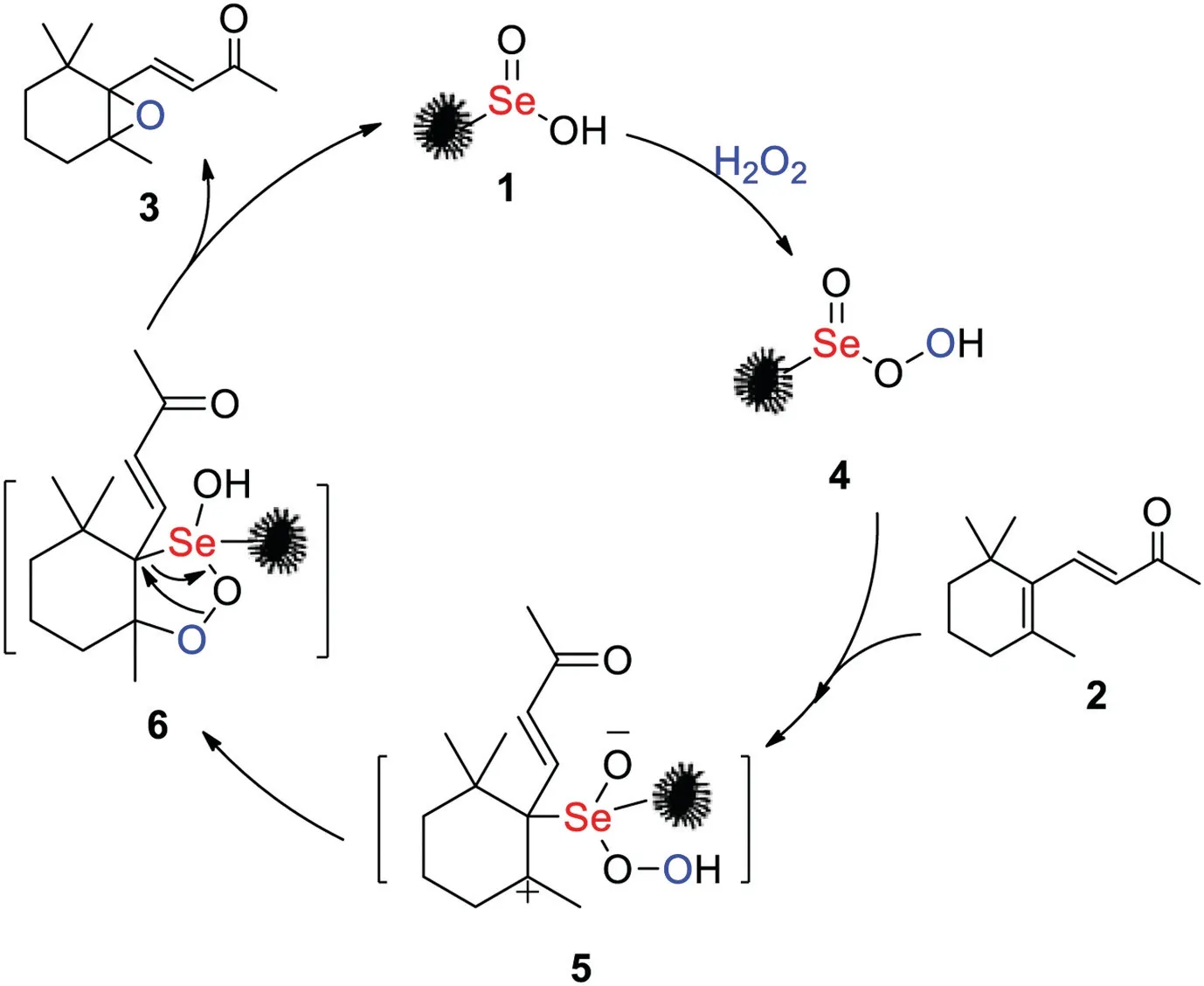
Scheme 1.Mechanism of Se/C-catalyzed epoxidation of β- ionone.
Similar to sulfur,the carbon-supported selenic acid derivatives can participate the reaction as acid catalyst in some cases.The rearrangement reaction of ethyl 2-(2-aminothiazole-4-yl)-2-hydroxyiminoacetate (7) is a typical example[43].Heating 7 in DMC in the presence of Se/C and 50 mol% of H2O2,the Beckmann rearrangement occurred instead of the expected oxidative deoximation reaction (Eq.3) [44-46].Product 8 [i.e.,ethyl(2-aminothiazole-4-carbonyl)carbamate]is the key intermediate for the synthesis of Cefixime derivatives.Thus,this reaction may provide a green method for producing the related pharmaceutical intermediates free of transition metal residues,and this is favorable for the related production in pharmaceutical industry.

Steric hindrance of the substrate molecule was considered to be the reason why oxidative deoximation reaction could notoccur.Unlike small organoselenium molecules,the huge carbon support of Se/C might prevent the nucleophilic attack of the peroxyselenite to oxime (Eq.4),which was the key step for oxidative deoximation reactions via the ionic reaction mechanisms.The result indicated that developing new catalysts that could work via free radical mechanisms might overcome the steric hindrance issue for oxidative deoximation of bulky substrates owing to the higher reaction energy of the radicals.Therefore,organotellurium catalysts were then employed in the next-step investigations to initiate the free radical reactions owing to the even weaker tellurium-containing bonds endowing the homo cleavages for radicals generation [47-49].

Besides catalysis,Se/C was also applied in the development of antibacterial agents owing to the bio-activity of selenium.For example,Xanthomonas campestris pv.campestris(Xcc)is a harmful pathogen causing the devastating black rot diseases.The leaves of plant infected with Xcc will soon wither(Fig.4),resulting in huge economic losses[50].Present methods for restraining Xcc employ antibiotics,which are environment-unfriendly.Intake of the antibiotic residues may cause the gradually increased drug resistances of bacteria and result in the emergence of superbugs,which is a great threat for both human beings and animals.Developing antibiotic-free method is the recognized trend in the field.
Se/C was recently successfully applied on restraining Xcc [51].EC50value of Se/C against Xcc was determined to be 4.7403 mg/L,affording a potential material for the cabbage black rot disease prevention and cure.Selenium restrained Xcc via interruption of bacteria cell membrane and increased generation of bacterial intracellular reactive oxygen species.Notably,as a water-insoluble material,after spraying the aqueous suspension of Se/C into the field,the material could adhere onto the plant leaves for a long time to allow a slow and sustained release of its efficacy.Related large field experiments are ongoing to get sufficient data for applying the antibacterial material at the agricultural engineering level.
Moreover,the selenium doped carbon could be applied in the protection of environments and biosystems.For example,Zhu et al.found that the Se/C hierarchical nanobelts could well adsorb heavy metals such as Cu,Ni and Cr [52].The related techniques are expected to be applied in the wastewater treatment.Xu et al.reported that the selenium-doped carbon quantum dots could scavenge free radicals to protect biosystems from oxidative stress[53].
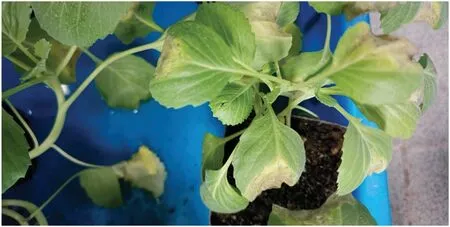
Fig.4.Disease symptoms of Xcc infection.
4.Selenium-doped polymeric carbon nitride
Polymeric carbon nitride (PCN)is a novel carbon material that attracts much attention in recent years [54].It possesses appropriated band gap for visible light-driven photocatalysis and is a fascinating material in catalyst development[55-58].PCN can be fabricated from the abundant and cheap nitrogencontaining chemicals such as urea and melamine,and this makes the material practical from the industrial application viewpoint.PCN possesses 2D structures like graphene,but contains a lot of amino and imino groups,which can coordinate with metals and makes this material a good platform to anchor desired catalytic metals [59-61].
Selenium can be used as a structure-directing agent in the PCN materials design [62].Doping with Se,the surface area of the material and total mesoporous volume were obviously enhanced due to the sublimation of selenium powder in the calcining process.This change in structure endowed the asprepared material even higher catalytic activity.For example,the Pd@PCN-Se catalyzed oxidation of diphenylmethanol (10)produced benzophenone (11) in excellent yield and the catalyst was recyclable (Table 1,entry 1).Using Pd@PCN,PCN-Se,PCN,Se,PCN+Se,PCN+Se+PdCl2,Pd@PCN+PCN-Se,Pd@PCN+(PhSe)2,Pd@PCN+Se,Pd(OAc)2or Pd(OAc)2+(PhSe)2as catalyst instead of Pd@PCN-Se all resulted in decreased product yield(Table 1,entries 1 vs.2-12),indicating that the interaction of Pd,PCN and Se was the key to ensure the high catalytic activity of the material,which was also attested by the X-ray photoelectron spectroscopy analysis.Moreover,catalytic activities of the PCN materials(PCN and the derived Pd@PCN) prepared via reference-reported[63]two-step calcination method were lower than Pd@PCN-Se(Table 1,entries 13,14 vs.1),showing that selenium should be a nice dopant in carbon materials fabrication.The substrate scope was extended to a series of substituted secondary alcohols to produce ketones,and Pd@PCN-Se exhibited obviously higher catalytic activities than both Pd@PCN and PCN materials in all cases [62].
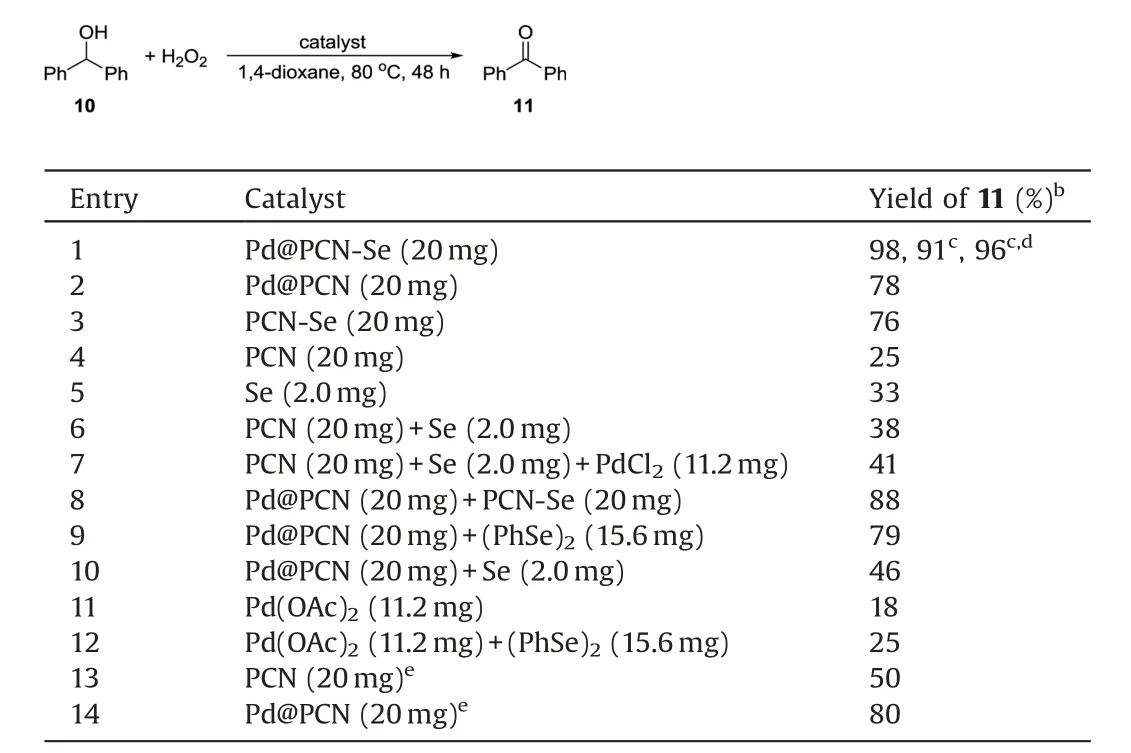
Table 1Catalyst comparison through the diphenylmethanol oxidation reactions.a
PCN-Se can also directly catalyze the oxidation reactions without additional metals.Shi et al.reported that,driven by visible light,PCN-Se could catalyze the epoxidation of β-ionone to produce the epoxide 6 selectively(Eq.5)[64].The reaction utilized both of the water photolysis features of PCN and the oxygen carrier features of Se.The use of water as the H2O2precursor instead of explosive H2O2makes this protocol safer and more practical for engineering.

As illustrated in Scheme 2,in the process,the PCN-catalyzed photolysis of water generate H2O2in situ,which could oxidize the supported selenium into its selenic acid form(12).Oxidation of 2 with 12 led to the epoxide 3 and released the selenium species 13,which was oxidized by H2O2to regenerate 12 and restart the catalysis circle.
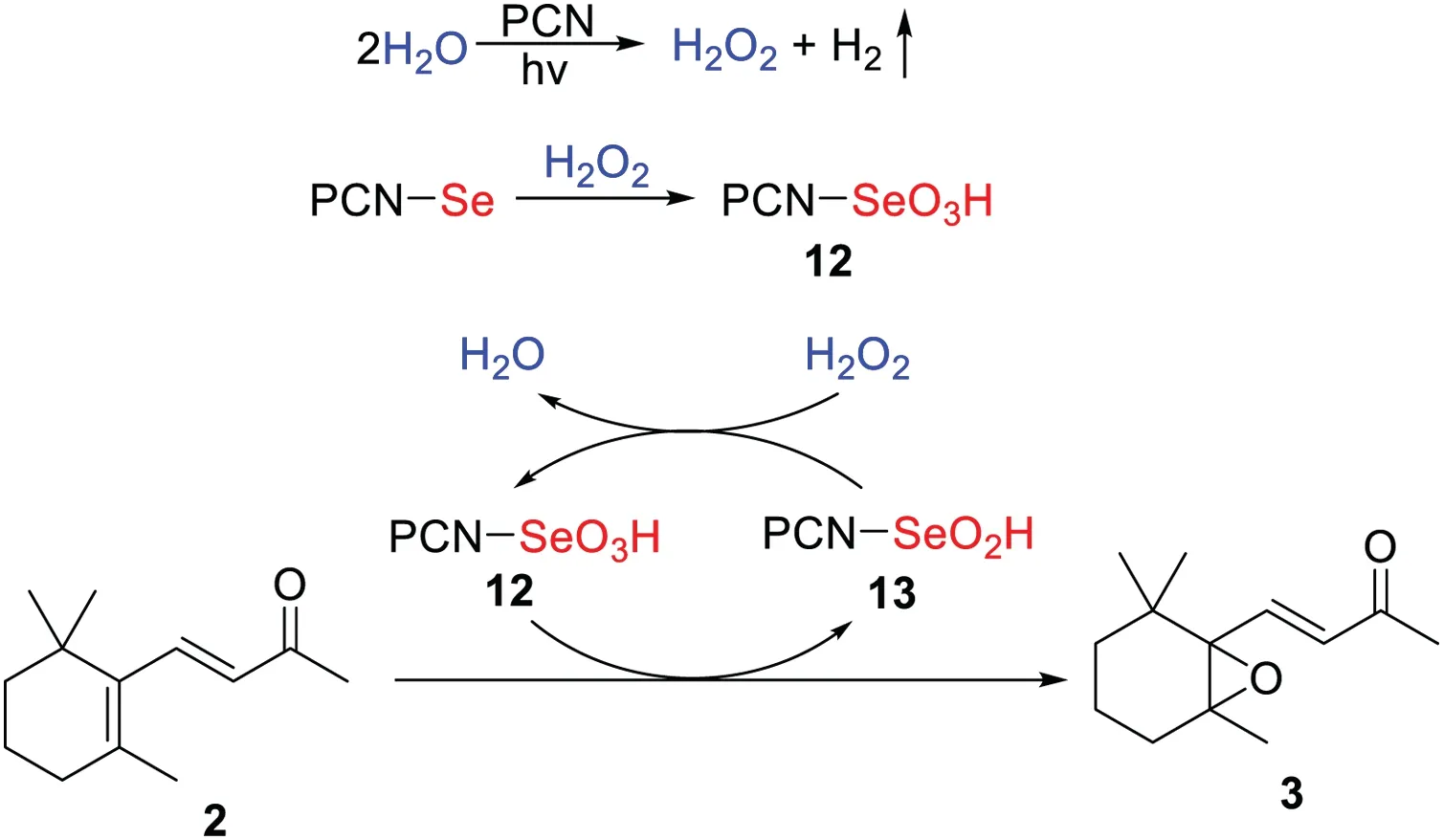
Scheme 2.Mechanism of PCN-Se-catalyzed epoxidation of β- ionone.
Selenium can catalyze the oxidative degradation reactions of organic compounds [65,66].Therefore,PCN-Se as a seleniumcontaining material may be applied in environment protection for both of its strong photocatalytic activity and the oxygen carrier features of selenium leading to the oxidative decomposition of organic pollutants.Recently,this material was successfully applied in the development of aldehydes scavenger[67].Catalyzed by PCNSe and irradiated by the blue LEDs light,over 80%of the aldehydecould be oxidized into CO2after 12 h.This finding led to an access to the visible light responsive materials for indoor organic pollutants and is of great applications in the home decoration materials production.
Moreover,PCN-Se was also employed in heavy metal removing owing to the strong coordination of its amino and imino groups with the metals.Recently,Zhang et al.successfully applied the material in Ni,Cu and Pb removing and it was found that the selenium-doped material (PCN-Se) was obviously better than simple PCN for its enlarged surface area and total mesoporous volume caused by the selenium sublimation during the material fabrication process [68].
5.Conclusions and perspectives
In conclusion,carbon-based selenium-containing materials are environment-friendly materials owing to the bio-compatible features of carbon and selenium.Their costs are acceptable for practical applications.The unique chemical-and bio-activities of selenium endow them wide range of applications in engineering.They have been successfully applied as selenium fertilizer in planting the selenium-enriched agricultural products,which are popular in China with obviously enhanced profits,as catalysts in green synthesis and organic pollutant degradation,as environment-safe biocides in the control of plant diseases and as the heavy metal scavengers in environment-protection.Researches in the field are interdisciplinary and require broad academic visions of the investigators.Multidisciplinary cooperations and developing the convenient commercial selenization reagent for engineering purpose to remove the barrier for investigators with poor skills for synthetic experiments can obviously facilitate and accelerate the research progress.The investigations in the field are booming for developing the related advanced materials [69]with broad application scopes [70].
Declaration of competing interest
The authors report no declarations of interest.
Acknowledgments
We thank the Natural Science Foundation of Guangling College(No.ZKZZ18001),Jiangsu Provincial Six Talent Peaks Project (No.XCL-090)and Priority Academic Program Development of Jiangsu Higher Education Institutions (PAPD) for financial support.We thank Prof.Tao Li(Yangzhou University),Associate Prof.Shuzhong Yuan (Yangzhou University) and Jian Liu (Sichuan Selewood Technology Co.,Ltd.) for providing us the photographs used in this article.Yu specially thank the co-workers of Yangzhou Bangjie New Material Co.,Ltd.(Prof.Ming Zhang,Shilong Yu,Yapeng Zhang and Limin Hu) for improving the synthetic techniques of the selenium fertilizers.
杂志排行
Chinese Chemical Letters的其它文章
- Decatungstate as a direct hydrogen atom transfer photocatalyst for synthesis of trifluromethylthioesters from aldehydes ★
- Synthesis of[6-6-6]ABE tricyclic ring analogues of methyllycaconitine
- Host-guest inclusion for enhancing anticancer activity of pemetrexed against lung carcinoma and decreasing cytotoxicity to normal cells
- pH-Responsive amorphous room-temperature phosphorescence polymer featuring delayed fluorescence based on fluorescein
- Boronic acid-containing carbon dots array for sensitive identification of glycoproteins and cancer cells
- Ultrasmall green-emitting carbon nanodots with 80%photoluminescence quantum yield for lysosome imaging
